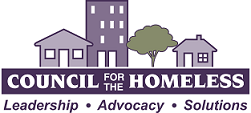
By Kate Budd, Executive Director of the Council for the Homeless
Thirty years ago in 1989, the Council for the Homeless was founded by Clark County, City of Vancouver and the Vancouver Housing Authority to lead and coordinate the work of addressing homelessness throughout Clark County. There are many accomplishments and milestones in this work both for our organization and for the community as a whole. Yet, factors that contribute to homelessness do not stand still and the conversations about solutions to homelessness are dynamic.
Throughout the Council’s rich history of 30 years much has changed around the realities of homelessness and some things have remained the same. Consider this; in 1999, I nervously signed my first rental agreement for an eclectically furnished basement studio for $295 per month. I worried about coming up with the money, working two part-time barely over minimum wage jobs, balancing college and trying to make sure my basic needs were met. Unfortunately, the owner of the home died and the new owner increased the rent by $100 a month. I gave up my coveted free day Sunday and worked more hours to make sure the costs were covered.
Now fast forward, 20 years later and I hear experiences like mine from callers to our Housing Hotline on a daily basis, except on exponential levels. Rent for a one bedroom apartment in our community averages over $1200, rent increases are averaging $100-$300 per month and there are not enough hours in the day for someone to increase their work hours in order to cover the rent and basic needs. We have seen the tipping point. People in Clark County who have been stable in their housing, families, seniors, Veterans, individuals are falling into homelessness or teetering on the brink while their support systems are doing all they can.
At the same time, Clark County is seeing the number of people experiencing homelessness in our neighborhoods and shopping areas rise. This is primarily because the former safe spots to simply “be alive” on the waterfront, by Share House, in the undeveloped wooded area and in the safety of a car in quiet neighborhoods are being razed by increased development and rehabilitation, as well as stigma related to homelessness.
With an increase in visible homelessness there has also been an increase in business owners and people who are housed seeing addiction, mental health, and criminal issues. These are challenges, but they are not the same as homelessness and they certainly do not always go together. Fact is there are far more people with behavioral health and criminal issues housed than there are unhoused in our community and across the nation.
As all these challenges become more visible and frustrations rise I hear more about nothing happening or one entity doing a better job than another. The fact is, there is much happening each day to make the trauma of homelessness more bearable and to end homelessness for those in our community, which means providing a stable, decent, non-time limited place to live. Agencies, faith communities, governments, businesses and others who collaborate in Clark County have a long history or working together and digging deep to address gaps.
In the collective conversations around homelessness in Clark County, it is imperative that we remember:
Looking to 2019 and beyond it is the long-time Clark County approach of community agencies, funders and members coming together, including those with lived experience of homelessness, working collectively that will make homelessness rare-brief and one-time. Unity in the approach through collective leadership is the only effective pathway to solutions. We must work together collaboratively to end homelessness. I am proud to be part of Council for the Homeless celebrating 30 Years of Impact. Please join us to keep these conversations going. Together we can move forward on the action steps that will make a difference for everyone in our community.


